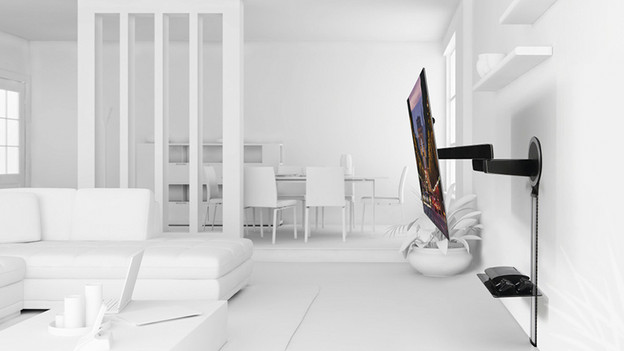
Written by Laurence
Edited on
27 January 2025
·
13:10
What type of TV mount should you choose?
You want to mount a television to the wall, but you don't know what type of TV mount you should choose. Do you want a fixed, tiltable or swivel design? With this article, I'll help you to make the best choice.

Choose a wall mount
In addition to the VESA size and proper screen size, flexibility is the main difference between wall mounts. Some mounts can be used to mount a TV tightly against the wall, while other mounts allows you to tilt a TV towards every corner of the room.
- Fixed wall mounts: mount your TV tightly against the wall
- Tiltable wall mounts: tilt the TV downwards when it's high up on the wall
- Swivel wall mounts: easily tilt the TV towards different viewing positions
- Swiveling and tiltable wall mounts: full flexibility

Fixed: tight against the wall
A fixed wall mount has a simple and sleek design. With this mount, you can mount a television tightly against the wall. With most fixed wall mounts, you only have 1 to 3cm of space between the TV and the wall. The disadvantage is that you can't move the TV after assembly. Only go for a fixed wall mount if the TV is exactly in front of your viewing position.

Tiltable: high on the wall
If you mount the television in a high place, the screen will be less visible. You can solve this with a tiltable wall mount, which you can use to tilt a TV a maximum of 15 degrees downwards. With some wall mounts, you can also tilt a television upwards. It's easier to access the connectors at the bottom of the device.

Swivel: different viewing positions
With this mount, you can turn a television to the left or right. This is useful when you have 2 or more viewing positions, such as your couch and dining table. Most swivel wall mounts have an adjustable arm that allows you to adjust the viewing distance. When 1 of your viewing positions is far from the TV, simply pull the device towards you.

Tiltable and swivel: full flexibility
If you want to move a TV in all directions, go for a swivel and tiltable wall mount. With this, you can always create the ideal viewing angle, wherever you are in the room. Keep in mind that you can't usually mount the TV tightly against the wall. This is because the swivel and tilt mechanisms of these mounts take up 5 to 10cm of space.

Check the VESA size
When you choose a wall mount, you shouldn't only consider the suitable TV size and weight, but also the VESA size. This size shows how many millimeters are between the attachment points. To ensure the mount fits on the TV, the VESA size of both products has to be the same.

Stores
Do you want personal advice? Our experts in the Coolblue stores are happy to help you choose. Click the button on this page to get an overview of all Coolblue stores.
Article by Laurence
Television Expert.
